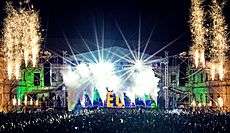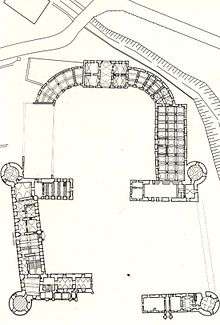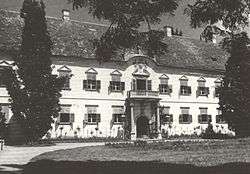Bonțida Bánffy Castle
| Bánffy Castle | |
|---|---|
|
Castelul Bánffy (Romanian) Bánffy-kastély (Hungarian) | |
|
Bánffy Castle under heavy restoration in July 2014 | |
 Bánffy Castle Location within Romania | |
| General information | |
| Status | Renovated |
| Type | Castle |
| Architectural style | Baroque |
| Location | Bonțida, Cluj County |
| Coordinates | 46°54′36″N 23°48′36″E / 46.91000°N 23.81000°E |
| Construction started | 1437 |
| Completed | 1890 |
| Renovated | 1999–present |
| Owner | Katalin Bánffy |
| Design and construction | |
| Architect |
Agostino Serena Joseph Emanuel Fischer von Erlach Anton Kagerbauer |
Bánffy Castle is an architectonic Baroque monument situated in Bonţida, a village in the vicinity of Cluj-Napoca, Romania. It was owned by the Bánffy family (of which Miklós Bánffy was a member). The owner is Katalin Bánffy, who has two daughters, Nicolette and Elisabeth.
History
In 1387, the Bonțida estate came into the possession of the Bánffy of Losonc family, when Sigismund of Luxemburg donated it to Dénes, son of Tamás Losonci.[1] The present castle was preceded by a manor house, whose history dates back to the 15th-16th centuries. After 1640, the estate was inherited by Dénes Bánffy (II) (1638–1674), county governor of Dăbâca and Cluj counties, brother-in-law and counselor of Prince Michael I Apafi, who fortified the initial building between 1668 and 1674 by surrounding it with curtain walls that formed a rectangular enclosure, reinforced at the corners with massive circular towers. The castle could be accessed through a seven-storey high gatehouse located on the fortification's eastern side. The works were continued after his death by his successor, György Bánffy (III).
This Renaissance ensemble was involved, between 1704 and 1711, in Rákóczi's War of Independence, needing repairs and restorations at the beginning of the 18th century.
In the 18th century the estate was inherited by Dénes Bánffy (IV), who, after a time spent in the Viennese Court of Empress Maria Theresa, returned home in 1747 and started a reconstruction of the castle in Austrian Baroque style. Between 1747 and 1751 a Cour d'honneur in U shape was built to the eastern side of the Renaissance building, which contained: the riding school, the stable, the carriage rooms and servants' quarters. An important achievement was the castle's park near the Someș River, with walkways, statues and fountains. In the integrative concept specific to Baroque art, the residence and the environment were in a relationship of close interdependence and mutual influence. Based on this concept, the park of 70 ha was set up after the design of architect Johann Christian Erras, which transposed into this space forms dominated by a strict geometry. The sculptor Johann Nachtigall made grandiose stone statues inspired by the ancient poet Ovid.[2]


József Bánffy, the descendant of Dénes Bánffy, decided the demolition of the gate tower in the 1820s, uniting the Renaissance courtyard with the Baroque one, and from the resulting stone a water mill was built for the villagers in Bonțida. In 1850 building's western wing was modified under the direction of architect Anton Kagerbauer (1814–1872), following the park's landscaping after the English Romanticism model.[2]
In 1944, the castle was transformed into a field hospital. German troops plundered and devastated the castle, as retaliation against political attitude of its owner, count Miklós Bánffy, which has initiated negotiations between the governments of Romania and Hungary for the return of weapons against Germany.[3] Thus, the furniture, the library and the gallery of paintings were destroyed.
During the communist regime, whole building was used as a driving school, cooperative farm and hospital for children. In 1963, Bánffy Castle was used as decor for filming Pădurea spânzuraților, directed by Liviu Ciulei. The film comprised a short scene with fire, thus scenographers lit one of the buildings, causing massive damage to the building.[4]
In 1990, the castle was declared a historic monument, and in 1999 began the restoration and rehabilitation works, with the support of several Romanian and foreign institutions and organizations, under the patronage of Prince Charles of Wales, who visited the castle several times.[5]
Gallery
-

The castle in 1890
-

Bonţida Bánffy Castle depicted by Cserna Karoly in The Austro-Hungarian Monarchy in Word and Picture, volume 23, 1902
-

The castle in 1935
-

Castle's interior in 1935
-
The castle in 2005, before being restored
-

Bonţida Bánffy Castle partially restored, in April 2011
See also
References
- ↑ "Castelul Banffy". descopera.net (in Romanian). 2 February 2012.
- 1 2 "Castelele Bánffy din Răscruci și Bonțida". Clujul - peisaj cultural (in Romanian).
- ↑ "Castelul Bánffy din Bonțida". amfostacolo.ro (in Romanian).
- ↑ "Castelul Bánffy din Bonțida". CeSaVezi.ro (in Romanian).
- ↑ "Prezentarea Castelului Bánffy din Bonțida". Transilvania Trust (in Romanian).
Coordinates: 46°54′36″N 23°48′36″E / 46.91000°N 23.81000°E